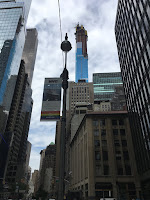Whenever I am in the city, I am astounded by the way it’s an entire universe unto itself. The physical, cultural and human geography of the streets of Manhattan is unlike anything else in America. Walking north from Penn Station yesterday, I realized New York is one of the few places where I don’t seem to notice the plants – probably because all my senses are overwhelmed by other details.
I recently read an article about the way in which newsstands no longer sell newspapers (since so few people buy the physical version). One company is trying to rebrand some of the stands as a mix between an Apple store and a bodega. Yesterday, I saw evidence that this trend is real.
I was amazed at how few newspapers and magazines were displayed at the newsstands. They’d been replaced by snacks, trinkets, and lots of electronics. It was a bit sad to see. During my time living in Boston and New York, I loved the view of a newsstand displaying hundreds of magazines (the one in Harvard Square was the absolute best) – it was a chance to see the world’s variety in miniature, on the covers of the various papers and magazines.
Another change I noticed is the proliferation of bike rental stations along the streets. I don’t quite understand how the economics of bike (or scooter) rental can work in a smaller town like Charlottesville, but it makes a ton of sense in New York City. I hope that we move quickly towards a European model in which bikes play a more prominent role in how we get around.
 A third change is the dominance of financial institutions along New York’s streets, including global banks like Barclay’s and BNP Paribas. Perhaps banks have always been a major part of the urban landscape and I just didn’t notice it when I was younger? In either event, the ubiquity of banking strikes me as a metaphor for both the changing American economy (and its domination by financial and other service institutions) and the problem of inequality.
A third change is the dominance of financial institutions along New York’s streets, including global banks like Barclay’s and BNP Paribas. Perhaps banks have always been a major part of the urban landscape and I just didn’t notice it when I was younger? In either event, the ubiquity of banking strikes me as a metaphor for both the changing American economy (and its domination by financial and other service institutions) and the problem of inequality.I closed my afternoon in the peace of Central Park (the Sheep Meadow, specifically). Once there, I did start to notice the plants. For his efforts to preserve natural places in our big cities, Frederick Law Olmsted has to take the prize as one of America’s great visionaries!


